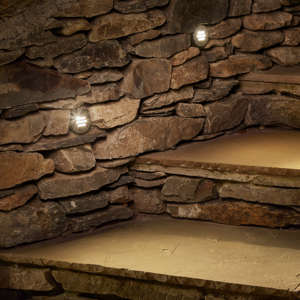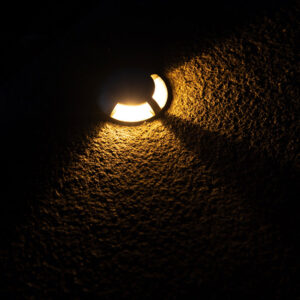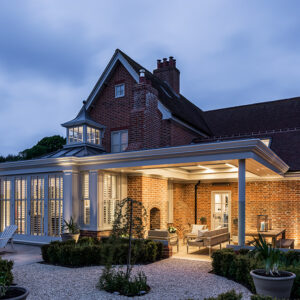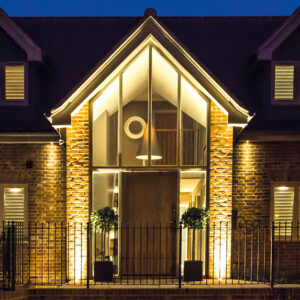Provide a warm, welcoming impression for your guests
Whether you are in a townhouse, a country cottage, or a manor; lighting up a front door can be a challenging exercise. Finding the right balance between form and function, as well as paying attention to the effect on wildlife, are some of the factors that go into the decision of the appropriate luminaire. This article will outline the aspects of the thought processes that lighting designers go through, alongside highlighting some of the challenges that are commonly faced and will provide an overview of the lighting choices that are available to fulfil the brief.
We are currently in the midst of a lighting revolution. The growth of LED light sources has accelerated over the past decade and this makes the lighting industry one of the most dynamic in the economy at large. The quality of the LED chips, both in terms of longevity and breadth of lighting effect, has driven the topic of lighting further into the public consciousness. The conversation, particularly for residential lighting, has shifted from energy savings (compared to older technologies like Halogen) toward the impact and effect that lighting can generate. There is more choice available for the lighting design community and, by extension, the homeowner than ever before. This becomes apparent when almost every other house in the town, village or area that you live in has decorative exterior lighting in some way, shape or form.
The question that arises is how to deliver what is required, rather than how to make do with what is available.

First impression
Much in the same way that an individual has a few seconds to create a first impression; the same is true of the home. Arriving up the driveway, walking up the steps or even passing by from a distance – the impression that one has of the front door will extend into their thoughts about the home as a whole. The house needs to feel homely, warm and welcoming. There are many ways in which this can be achieved and, as alluded to, some are impacted by possible restrictions on the building itself. Grade I and II listed buildings and streets can have restrictions, as well as other localised quirks. Dark skies policies and impacts on wildlife, particularly bats and other nocturnal animals, restrict the up-spill of light and the colour temperature used. There is another article on the Collingwood website regarding this important topic.
Statement
The decision of the statement to make is one of the first and most thought provoking to be made. There is, naturally, no correct answer to this question. Smaller homes or traditional buildings may be better suited to an understated entrance and homes with long driveways and approaches can certainly benefit from an impactful approach, however, it will be a subjective opinion about whether a grandiose impact or a subtle impression is the best fit for the application in question.
After deciding on the statement that is desired, thought needs to turn to the specificities of the building. A first view of the façade that will be lit can present some interesting possibilities. Cotswold stone or ironstone, for example, has a number of intriguing elements to it. Firstly, the nature of the build, which uses this type of stone, will likely show a degree of undulation. This undulation can be lit in a way as to create textures and allow the designer to play with light and shadow, ultimately creating a sense of drama in the exterior of the home and doorway. By day, patterns of sunlight will not show this texture, but at night, the use of low-mid power ground lights or wall lights will transform the building entirely.

Textures
For textures in stone and brickwork to be fully accentuated, the placement of the fittings is incredibly important and can be an art unto itself. If the fittings are placed too close or too far away from the wall then the effect of texture and the light and shadow effect will be minimal or at worst, eliminated. This point is most relevant to ground / uplights as opposed to wall lights, whose placement is more-or-less predetermined. Clever use of beam angles can distinguish strong lighting designs from the crowd. Narrow beam angles can direct light further up columns and more effectively direct attention to an architectural feature. Wider beam angles can provide a more even spread of light with a more diffused effect further up the building.
Colours
Next, consider the colours and hues contained within the fascia. Natural stones, woods or even brickwork are not monochrome. There are subtleties in the elements of the compositions. Reds, ambers and other warmer tones will take on different lives when put under warm white colour temperatures and whites, creams and softer pallets may be more suitable to colour temperatures closer to neutral white.

Features
Other architectural features around the door need to be considered. Steps and paths up to the door, from those under one metre from the street to extended lengths, can benefit from being well lit. The primary function may be to guide people up toward the door on a dark evening. Subtle low-level lighting, such as step lights or mini domed marker lights will push and wash light across the ground without overt levels of impact on the wider environment. The GL100 mini domed marker light is a discreet choice to use. The body comes in stainless steel for a timeless appearance or an antique brass to further enhance the warm tones of the building materials used. There are four types of window option to push the light wherever is desired and most impactful. The domed top minimises any form of upward light spill and focusses the visitor on the path, rather than the glare of the fitting.
Glare
Glare is important to minimise so that concentration is on the effect of the lighting, rather than the light source. There are several options to help achieve this. Ground lights have scope to recess the light engine into the body of the fitting. The low glare and ultra-low glare options in the landscape range were developed exclusively for that purpose, alongside the use of frosted lenses for more diffused lighting patterns. Accessories like low glare hoods and snoots can be applied to spike lights and wall lights to create a similar effect. The purpose of these accessories is to further conceal the light source from immediate view, whilst allowing the lit effect to be the main focal point
 Porch lighting
Porch lighting
Porches or porch rooves are somewhat commonplace to protect visitors from inclement weather when close to the front door and can be lit in different ways, depending on its construction and the degree of focus that is required. Oak framed constructions may be more interesting to illuminate than those with varnished MDF, for example. Light can also be used to hide what you do not want to see. Just because something is there does not mean that it needs to be lit. The use of more simplistic soffit downlights can be used to create a pool of light on the floor in the porch can be an effective option for those people that want a functional application of light, rather than a more architectural effect. The H2 Pro Extreme is the only downlight choice available today that is suitable for this, failing that, larger luminaires like bulkheads are commonly chosen. The porch roof can be a useful element to create interesting effects. The use of a single up/down wall light in a central position can use the reflectance of the roof to create a bright and inviting space. The downward light can simultaneously create a wash down the door and pool on the step, whilst the uplight element illuminates the whole of the porch roof, which in turn contains the spread of light.
Front door lighting
Following this, attention now turns to the front door itself. If there are specific features to highlight in the door then action should be taken to this effect. Stained glass window elements can be lit to create unique appeal from outside and from within the home. Solid wooden doors offer natural hues to play with, whilst vibrant monochrome colours can make the door a clear centrepiece to highlight. The placement of the door can sometimes make the decision for the lighting designer. If the door is recessed then choices around highlighting architectural features of the building can leave the door in relative darkness, creating interest and intrigue. Alternatively, use of diffused and softer light can frame the door to achieve a similar emotion.
 Controls
Controls
Finally, attention needs to turn to the controls. Controlling the lighting can be automatic or manual. This is so that the lights are used when required and not left on by accident during the day. As the seasons change and the length of day changes, a simple automatic timer may not be appropriate. The growing availability of smart systems can automate the lighting, taking the thought out of the process. The use of presence detectors (often referred to as PIR, or passive infrated, sensors) can be useful to turn the lighting on when people approaching trigger the lights to turn on. Alternatively, simple switching can be most useful for homeowners who can operate simply and easily for their requirements
Overall, the decisions on what may appear to be a small element of the home are vast and plentiful. To create the emotions, the impact and the statement desired requires thought in many areas. This is the challenge faced by the lighting designer and the homeowner in conjunction, to both understand what the impression is to give off to those approaching the home and then how to use the variety of architectural features to deliver it with appropriate lighting designs. There is a wealth of further reading elsewhere on the Collingwood website, literature and within our teams.



